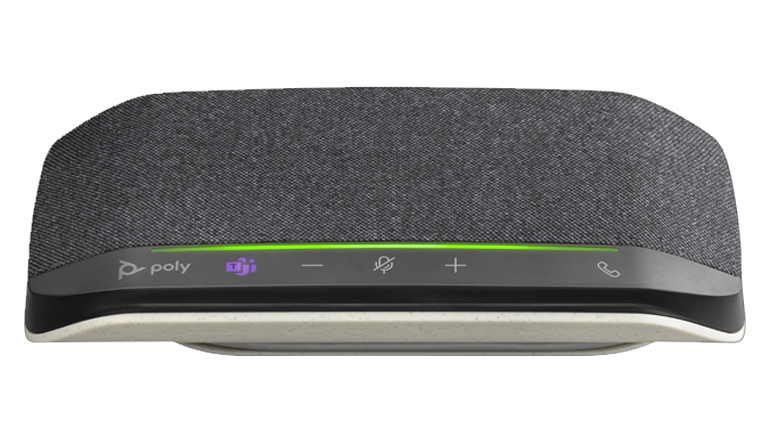There are also two larger and more expansive options in the range: the $299.95 Poly Sync 40 for flexible-working spaces and huddle rooms, and the $599.95 Poly Sync 60, which is designed for conference rooms.
According to Poly’s website, the Sync 10 is ideal for “remote enterprise professionals with a dedicated home office”, while the Sync 20 is better suited to “Flexible enterprise professionals who split time between corporate office, home office, and travel”.
Given that mobile workers want to keep their bag as light as possible, and while the differences in size and weight are slight, the smaller, lighter Poly Sync 10 may suit both types of user. But size and weight are not the whole story, and the Poly Sync 10 is missing some key features – even for primarily home-based users.
Design across the Poly Sync range is very similar, with a rather nice curved rectangular form factor and primarily fabric grey upper section, with a narrow strip of touch buttons for managing calls and volume. Importantly for those who use Microsoft Teams, there’s a Teams-certified version with a dedicated button on the front panel to instantly connect with the Teams app. Both the Poly Sync 10 and 20 have an IP64 rating for dust and water resistance.
Connectivity to a PC or laptop is wired. The cable curls underneath the device and locks securely in place. It’s a USB-A cable, and there’s a USB-C converter included in the box. Every other speaker in the Poly Sync range has a Bluetooth adapter, which brings several advantages: it’s easier to conveniently locate the speaker when several people want to share access to a single laptop and speaker, and you can easily connect to a tablet or smartphone. Moreover, the cable here is only 71.5cm long. This is fine when you’re sitting at a desk having a meeting, but in more relaxed circumstances – when taking a family call, for example – the wired-only setup is restrictive.
SEE: Remote workers want new benefits. This is how employers are responding
There’s no battery in the Poly Sync 10, which is powered via its USB cable. The other speakers have an internal battery, and the Poly Sync 20 is rated for 20 hours of life. The Poly Sync 20 can be used to charge a tablet or phone via its cable – which is clearly not possible with the Sync 10.
In use the Poly Sync 10 was fine in my home office in terms of both microphone pickup and sound quality, although in both respects it’s less well specified than the Sync 20, with 1.5m microphone pickup range compared to 2m, and two microphones versus three.
Finally, the Poly Sync 10 doesn’t come with a carry case, while there is one with the Sync 20.
The Poly Sync 10 is small and light, and both the microphone and speaker perform well. However, even as a primarily home office-based user, I miss the Bluetooth and battery power that make the Poly Sync 20 much more flexible. Given the small price difference – currently just $15 – we’d recommend the latter.
Poly Sync 10 vs Poly Sync 20 specifications
Alternatives to consider
The Poly Sync 10 and 20 are among the more affordable speakerphones on the market. Here are a couple of more premium devices.
RECENT AND RELATED CONTENT
Poly Sync 20, hands on: Portable sound for work and play
HP to acquire Poly for $1.7 billion
Screen plays: The Poly Studio P21 offers more room for your Zoom
The best cheap Bluetooth speakers: Listen for less
Best Bluetooth speakers 2022: Here comes the boom
Read more reviews
Realme Pad Mini review: Nice price and great battery life, but too many trade-offsTCL Stylus 5G review: A solid sub-$300 stylus phoneBlack Shark 5 Pro review: A level upGarmin Quatix 7 review: The best GPS sailing watchNaenka Runner Diver headset review: Excellent sound, even underwater
